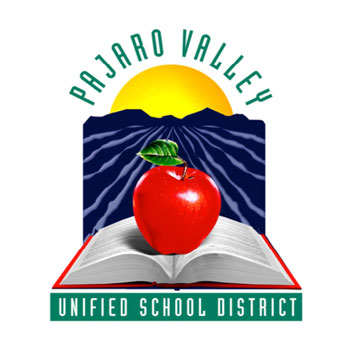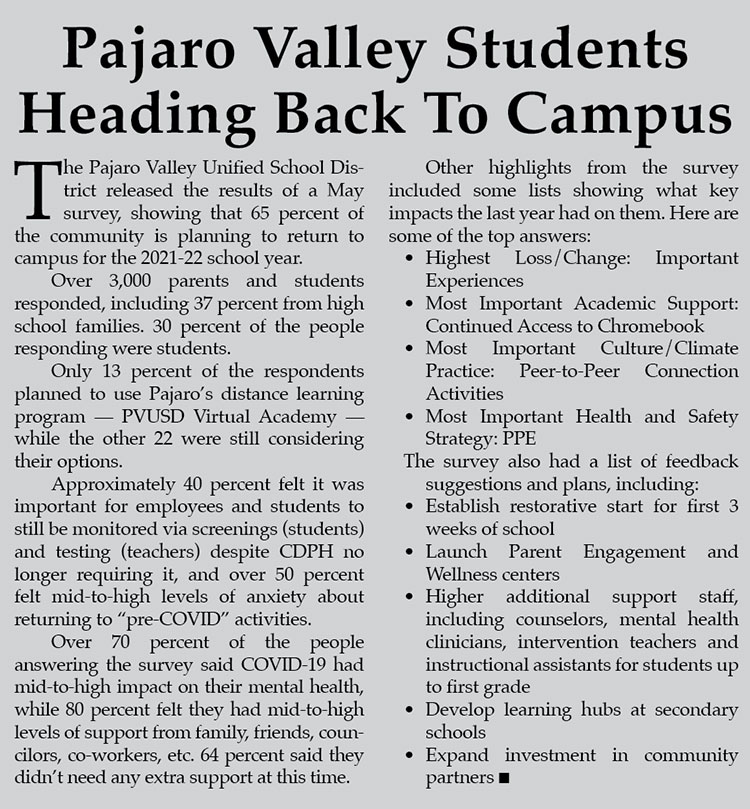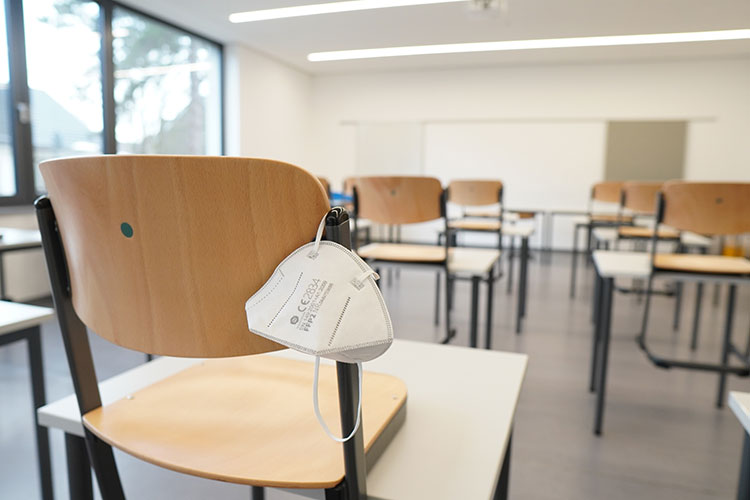Report on Distance Learning During the Pandemic in the Pajaro Valley Unified School District
In March of 2020, schools began closing across California as the realities of the COVID-19 pandemic hit home. The Pajaro Valley Unified School District (PVUSD), the largest in Santa Cruz County serving over 20,000 students, made plans to close for two weeks. PVUSD moved quickly, creating and putting plans in place that provided for distance learning and a way to communicate with students, teachers, and families. As it turned out, students were out of school for approximately one year.
 PVUSD is to be applauded for its agile and broad response to the COVID-19 pandemic. Within five days the district furnished the students with computers and internet access.
PVUSD is to be applauded for its agile and broad response to the COVID-19 pandemic. Within five days the district furnished the students with computers and internet access.
Teachers and students received training in distance learning. Social services were provided to families. Students, parents, and teachers have been surveyed numerous times, providing information on what worked and what did not.
PVUSD should analyze and apply these findings, and continue with evaluations when schools reopen. The findings should be documented and shared so that distance learning can be further improved in the upcoming school year and beyond to help students succeed. In our unpredictable world, distance learning is here to stay.
Background
The COVID-19 pandemic has forced students everywhere to employ new ways of learning when their schools closed down. The focus of this investigation is on PVUSD because it serves nearly half of all students in the county, contains the greatest percentage of low-income and Latinx families, and is in the area with the highest COVID-19 case rate in the county.
Within five days of the schools’ shutdown and the implementation of distance learning, PVUSD updated its webpage with information for the community and equipped all students with Chromebook computers and school supply bags to help prepare them for remote learning.
 Students without internet connection at home had Safe Spaces provided. These spaces gave students secure and safe places to do their school work and also served as a location for resources, with school staff working to meet individual student needs for food, clothing, and counseling support. Additionally, 500 hotspots, some in school busses, were made available throughout the district to ensure that all students had access to internet connections.
Students without internet connection at home had Safe Spaces provided. These spaces gave students secure and safe places to do their school work and also served as a location for resources, with school staff working to meet individual student needs for food, clothing, and counseling support. Additionally, 500 hotspots, some in school busses, were made available throughout the district to ensure that all students had access to internet connections.
Community programs provided families in need with meals, clothing, rental assistance, and counseling. Agencies collaborated to take care of their community by removing obstacles and finding innovative solutions. Funding through the CARES Act helped to improve and upgrade some of the heating, ventilation, and air conditioning systems in the district’s schools.
It should be noted that planning for school closures had been ongoing for months, beginning as early as January 2020. Superintendent Michelle Rodriguez sent the first communication to the educational community about COVID-19 on January 24,2020. The effect of the pandemic has been more severe for students living in poverty, are of color, LGBTQ, or have learning and/or social-emotional problems.
Teachers, too, have struggled, having to quickly learn new approaches to teach and communicate with students and families, often while parenting their own children in the home.
The Grand Jury wanted to find out how distance learning has worked for all concerned. It will be important for PVUSD to process the lessons learned so that distance learning can be utilized in the best possible way in the future.
On March 14, 2020, there were seven cases of COVID-19 in Santa Cruz County. One of them was an employee at Rio Del Mar Elementary School, part of PVUSD.
That same day, the PVUSD Board of Trustees held an emergency meeting to unanimously approve a plan to close all district schools for two weeks, and allow most employees to work from home.
As part of this mandate, PVUSD technology employees were tasked with disinfecting some 15,000 Chromebooks for students to use at home. The district, along with local company Cruzio and Equal Access Santa Cruz County, provided internet access to the district’s students, some of whom lived in remote areas of the county. Schools across the state were planning to close for one to two weeks.
However, PVUSD Superintendent Michelle Rodriguez said at the time, “This is not going to go away in a few weeks, so we need to have continuity of learning.”
Scope and Methodology
The Grand Jury conducted interviews of administrators, teachers, students, and parents. We listened to webinars featuring these groups.
We requested and examined documents and monitored newspapers, Facebook postings, and internet sources for updates on local school issues.
Investigation
The PVUSD, with over 20,000 students, is a large school district managing, 16 elementary schools, 6 middle schools, 3 high schools, 8 charter and alternative schools, and 1 adult education school.
On January 28, 2020 the PVUSD Superintendent sent out a note to staff and families informing the district about the potential of a COVID-19 pandemic, what individuals could do, and what actions PVUSD and the County Public Health Division was taking.
This was one of the earliest efforts to keep the community informed about COVID-19.
Dr. Rodriguez’s FAQs, which provided updated information on COVID-19 testing, vaccinations, safety protocols, internet access, and school closures, continued consistently throughout these early days and beyond.
On March 14, 2020, when the schools were ordered to stop in-person learning, it was not a complete surprise to the PVUSD administration, faculty, students and parents. Within five days of the schools’ shutdown and the implementation of distance learning, PVUSD equipped the district’s students with Chromebook computers and school supply bags to help prepare them for remote learning.
However, despite the tremendous success in providing the majority of students internet access, approximately 400 students don’t effectively participate. These students live in rural areas of the county. Some did not pick up their Chromebook or have reliable internet access, and some the district was unable to locate.
Social Anxiety
The social-emotional issues that students experienced during the pandemic have been worrisome for administrators, teachers, and parents.
Some students hesitate or avoid turning their computer cameras on because of privacy issues; they don’t want others to see how they live. Some are lonely, tired, depressed, or are being abused. Some have no one at home who can help with schoolwork and computer issues. Some have experienced serious illness and deaths in their families. Some are in desperate need of food, clothing, and housing. Others need to care for younger siblings while parents work, or need to work themselves to help out financially.
Teachers have been trained to look for signs of distress, and reach out to students and families via the Internet, mail, and phone. Home visits and support from PVUSD Student Services, Pajaro Valley Prevention and Student Assistance, and other social service agencies have increased. More funding and support for qualified outreach staff will be needed to effectively continue these services.
Some students, however, have thrived with distance learning. They say they have more time to focus on schoolwork and have fewer distractions and social pressures. Some like the ease with which they can communicate with teachers. Remote learning can be a complement to in-person learning, allowing students to explore additional areas of interest. It can also be used to help students needing extra help academically.
Governor Newsom has said it will definitely be a part of California’s educational system, even when schools reopen, and that money is available to help with funding. The pandemic offers an opportunity to think “out of the box.” “What we’re hearing very broadly from schools all across the state is that they do want to have some level of flexibility to continue to provide distance learning for some families,” said Kevin Gordon, president of Capitol Advisors, a lobbying firm representing hundreds of California school districts.
Parents Participate More
The role of parents has also changed during the pandemic. They are more involved now than ever before.
Virtual communication has made it easier to participate. The Superintendent’s office is concerned with the emotional needs of parents as well as the students. Parents can join live meetings and provide feedback. PVUSD sends out updates on the web at least once a week to provide current information and resources. Teachers have received continued support for digital training throughout this timespan of distance learning.
PVUSD provides a Digital Learning Resources website that provides direct assistance for teachers with technical support and access to tools and resources. The site also provides direct coaching support through the County Office of Education Teacher On Special Assignment (TOSA) program.
Parents and students have access to the website with online activities and distance learning support. Teachers have continued to receive training and support throughout the pandemic. They have put in hours of unpaid time to participate in trainings. While everyone — teachers, administrators, students, and families – is striving to make remote learning work, it has left many of them tired and frustrated.
Multi-Lingual Support
PVUSD has put a good deal of effort into reaching students and families who speak Spanish and Mixteco bajo, with multi-lingual family support staff and phone-based and in-person technical help.
The PVUSD superintendent has said it is important to listen, provide information, and engage families in their preferred language.
As schools reopen, safety protocols are a big challenge, as well as how to continue to help students academically, socially, and emotionally. The American Federation of Teachers (AFT) has laid out safeguards such as masks, physical distancing, sanitizing, ventilation upgrades, testing and contact tracing. Randi Weingarten, AFT president, said: We must reimagine learning beyond COVID-19 and create the conditions to help all children thrive.
Rather than the traditional spring state testing, we should assess and respond to students’ wide-ranging needs; support our most vulnerable students; focus on educators’ professional learning and growth to meet these unprecedented challenges; and promote equity and excellence in all of our public schools.
The PVUSD Board of Trustees has approved a plan to ease graduation requirements for high school students who have experienced learning loss. It was found that 85% of the seniors at Aptos High School are on track to graduate this year, along with 66% of those at Pajaro Valley High and 65% at Watsonville High – all percentages down from previous years.
As one local parent said, “Hopefully the focus won’t be on catching students up academically, but rather that they talk about the experience. There is a lot to be learned.”
Conclusion
The PVUSD Board of Trustees approved a plan to close all district schools for two weeks beginning on March 16, 2020. The District moved quickly, putting previously thought-out plans in place that provided for distance learning and a path for communicating with students, teachers, and families.
PVUSD is to be applauded for its agile and broad response to the COVID-19 pandemic. In the first five days after the schools shut down the district furnished the students with computers and internet access. Teachers and students received training in distance learning. Critical social services were provided to families. PVUSD can learn from the immediate and commendable actions taken to put distance learning in place.
This is the time to evaluate what worked and what didn’t. Classes look different as safety measures are established and there are new concerns as students and teachers have returned to the classroom.
PVUSD services need to be provided as the community heals from COVID-19, especially to those most vulnerable and difficult to locate.



